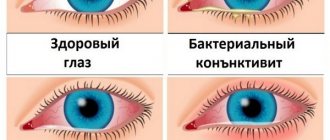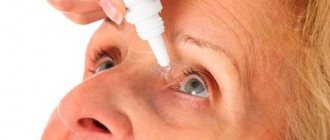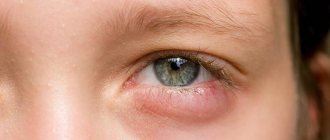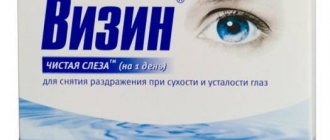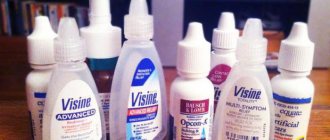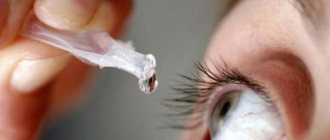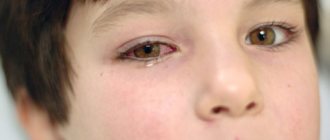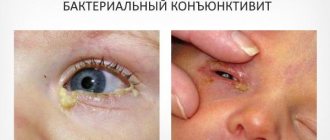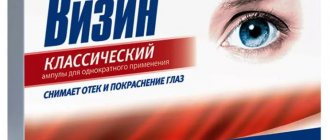Professor Christine Purslow (Department of Human Health Sciences, University of Plymouth (UK)) explains how the components of eye drops affect their properties and gives practical advice on their use.
- Scale of disaster
- Both young and old suffer from dry eyes
- Dry eye syndrome and its vicious circle
- What is included in eye drops?
- What are the ideal eye drops?
- Recommendations for patients on choosing the best drops
Scale of disaster
One in five adults suffers from chronic dry eyes, and many more experience recurring dry eye symptoms, which explains the growing demand for expert care and affordable eye medications. In one study [1], 19% of respondents used over-the-counter dry eye medications at least five times per week, but 69% of symptomatic adults did not seek professional medical help. Even worse, 63% of those who used the drops did not think they were effective! A conservative estimate of the number of people with dry eye in the UK is around 11 million, so it is important to understand the different features of current medications to make effective, confident recommendations. This article reviews the physiology of dry eye and presents key principles to consider and understand when choosing dry eye drops.
Price
The cost of eye drops varies quite significantly depending on what active ingredients are included in the drug, where they are produced and what the volume of the bottle is. Each drop has its own cost. Imported eye drops, naturally, are more expensive than domestic ones. As a rule, imported eye drops have cheaper domestic analogues that are practically not inferior in quality. Therefore, you can always choose the optimal drug based on a person’s wishes, as well as taking into account the necessary therapeutic effect and reasonable cost.
Both young and old suffer from dry eyes
The prevalence of dry eye syndrome among adults over 40 years of age in Western countries is approximately 20% [2] and increases with each decade of life, and it is one of the most common eye-related complaints in older people [3, 4]. Symptoms range from mild irritation and discomfort to debilitating pain. In fact, the burden and impact on quality of life of dry eye syndrome is comparable to angina pectoris [5]. Additionally, visual impairment resulting from tear film abnormalities is often underdiagnosed, with patients with dry eye syndrome three times more likely to report difficulty performing a variety of visual tasks [6] and may have slow reaction times when driving [7]. More and more young people are turning to specialists with symptoms of dry eyes, perhaps due to the fact that when concentrating, for example, when working at a computer, the frequency of blinking movements is halved, and if they wear contact lenses, half of them will complain to symptoms of dryness when wearing contact lenses [8], especially towards the end of the day [9].
Dry eye syndrome and its vicious circle
The tear film is a dynamic, transparent film that provides protection to the ocular surface by removing foreign particles and pathogens, wetting and hydrating epithelial cells, delivering oxygen and nutrients to the cornea (which is vascular), and lining the optical surface for light refraction in the eye. The microvilli of epithelial cells on the surface of the eye are attached to this thin film by a mixture of mucin and protein (called the glycocalyx); the aqueous layer is located above the glycocalyx (containing free mucin), and the adipose (lipid) layer is the uppermost one and is in contact with air. The lipid layer slows down the evaporation of the tear film, but is easily disrupted.
Rice. 1. Simplified structure of the tear film (not to scale)
Image courtesy of Thea Pharmaceuticals
Understanding the pathophysiology of dry eye syndrome is the key to successful treatment. During the interval between blinks, the tear film spreads over the surface of the eye and thins; It exhibits non-Newtonian and viscoelastic properties, meaning there is minimal resistance to the blinking movement of the eyelid, but the film becomes more viscous, protecting the eye when it is open. Understanding that the tear film is a high-viscosity, low-shear solution when the eye is open and low-viscosity, high-shear during blinking is important because certain eye drops contain ingredients that mimic these properties. Stability of the tear film, causing increased evaporation, is the most common modern cause of dry eye syndrome. True tear volume deficiency accounts for less than 20% of all cases of dry eye and is associated with conditions such as Sjögren's syndrome or is a side effect of a number of medications such as diuretics, beta blockers and antihistamines.
However, regardless of the triggering mechanism, the resulting chronic effect is that the remaining tear fluid becomes “concentrated,” increasing its osmolarity, which in turn causes inflammation and has a negative effect on the microvilli and mucin-producing cells on the surface of the eye. This further destabilizes the tear film, creating a so-called vicious cycle of dry eye syndrome, which increases and exacerbates inflammation that does not immediately resolve once the trigger is addressed. The more chronic the condition becomes, the greater the likelihood of developing inflammation of the ocular surface and the more urgently intervention is required. The goal of any treatment is to eliminate the trigger and relieve symptoms by selecting foods that break the cycle at key points (Figure 2).
Rice. 2. Activities that break the vicious circle of dry eye syndrome
In fact, treatment for dry eye consists more and more of treating the surface of the eye rather than replacing tear fluid
What is included in eye drops?
It is important to note that the combination of different physical properties, their behavior in vivo (which often differs from in vitro), plus individual patient factors such as blinking movements, is what determines the effectiveness or necessity of a product, as well as the preference of one product over another. The main components of interest are summarized below.
Solvent
Water is the main component of most eye drops - up to 97-99%
Emollients
Polymers, which act as emollients, are included in the solution to increase the mass of the tear film and “smooth” the surface of the eye. Many of the traditional products and earlier formulations contain a polysaccharide as a major component: carboxymethylcellulose (CMC) or hydroxypropylmethylcellulose (HPMC). Others are based on synthetic polyvinyl alcohol (PVA), and polyvinylpyrrolidone (PVP), and polyethylene glycol (PEG), which have greater water-holding capacity than CMC and HPMC. Newer products may also contain these ingredients, but their main component tends to promote normal osmolarity, which allows them to better mimic the shear properties of the tear film, usually hyaluronic acid and hydroxypropyl guar (see below).
A few words about viscosity
You might think that the higher the viscosity of the eye drops, the longer their effect on the patient's eye. However, there is no rigorous clinical data to support the idea that subtle differences in this effect between marketed eye drops are significant. When using gels, which have a much higher viscosity, we see a clear effect, but small differences between liquid preparations may be too subtle to be noticeable. One explanation may be that blinking movements restore the original viscosity of tear fluid very quickly, so more work is required to determine the optimal viscosity of liquid droplets.
Common components of eye drops (composition may vary):
- Solvent.
- "Active" molecule.
- Preservative.
- Buffer.
- Stabilizer.
- Substance that regulates tonicity.
- Polymerizing agent.
Tonicity control: electrolyte factor
Electrolytes in tear fluid, such as potassium, sodium, bicarbonate and magnesium, are essential for maintaining the tonicity of the solution, as well as for the preservation of goblet cells [10]. Electrolyte imbalance and/or excess electrolytes triggers an inflammatory response on the ocular surface. Some eye drops go a long way toward matching this natural balance or even correcting the imbalance, but most are hypertonic rather than the desired hypotonic composition. The solution must have a substantially lower osmotic pressure relative to the hyperosmolarity of the fluid in the dry eye to have the desired effect.
Preservatives
The most commonly used preservatives are benzalkonium chloride (BAC) and one of its derivatives, polyquaternium-1 (polyquad). Both are extremely effective types of cleansers, but the toxic effects of BAC are well documented in the literature. As awareness grows about the problems it can cause, especially for glaucoma patients using multiple types of drops at the same time, more preservative-free solutions are coming onto the market.
Buffering agents
Buffering agents are used to maintain the pH of tears (about 7.4 pH units) and prevent burning during instillation. The use of phosphates as a buffer in eye drops is controversial given the 2012 European Medicines Agency guidelines, which recommend phosphate-free medications to maintain ocular surface health. This is especially true for severe ocular surface disease, but some drug manufacturers have wisely avoided the use of phosphate buffers in over-the-counter and prescription products by using alternatives such as citrate buffers.
Lipids in eye drops
Considering that most cases of dry eyes are caused by increased evaporation of the tear film, the emergence of eye care solutions based on lipids or containing a lipid component is logical, but it should be remembered that this is a rather weak replacement for the natural product of the meibomian glands: the secretion they secrete is extremely complex a combination of fatty acids, their alcohol derivatives, sterols, sterol esters and triglycerides. A proper eyelid care regimen of heat, massage, and cleansing is the most effective strategy for most patients.
TECHNOLOGY FEATURES
Ophthalmic dosage forms must be sterile. Sterilization of ophthalmic dosage forms is carried out in accordance with the requirements of the General Pharmacopoeia Monograph “Sterilization”.
The osmolality of ophthalmic dosage forms should be within the osmolality range of 0.6 - 2.0% sodium chloride solution. The use of hyper- and hypo-osmotic eye drops is allowed, but usually the composition of eye drops with a concentration of medicinal substances below the equivalent 0.6% concentration of sodium chloride solution is subject to correction by adding appropriate excipients (sodium chloride, sodium sulfate, sodium nitrate, etc.).
The optimal pH value of ophthalmic dosage forms should correspond to the pH of tear fluid - 7.4. The pH value may differ from the optimal one, but should be in the range from 3.5 to 8.5.
To ensure the stability of ophthalmic dosage forms, their composition may include antioxidants: sodium sulfite, sodium metabisulfite, sodium thiosulfate; complexing agent: sodium edetate; preservatives: benzyl alcohol, chlorobutanol hydrate, methyl parahydroxybenzoate, propyl parahydroxybenzoate, benzalkonium chloride, boric acid at a concentration of 1.9-2.0%; substances that regulate the pH of the environment: buffer solutions, mono- and disubstituted sodium phosphate, sodium citrate, sodium hydroxide, sodium bicarbonate, sodium tetraborate, etc.
Increasing the duration of action of eye drops can be achieved by increasing their viscosity. To do this, use hydroxypropyl methylcellulose (0.3 - 0.5%), methylcellulose (0.1 - 0.7%), polyvinyl alcohol (1 - 2%), sodium carboxymethylcellulose (1 - 2%) and other prolongants approved for medical use. The optimal viscosity for eye drops is 5 - 15 mm2/s. The viscosity of eye drops may differ from the optimal values, but, as a rule, should not exceed 150 mm2/s.
Ophthalmic dosage forms for topical use in multi-dose packages must contain a suitable antimicrobial preservative in the required concentration, unless the active substance itself has sufficient antimicrobial activity. The selected antimicrobial preservatives must be compatible with other ingredients of the dosage form and remain effective throughout the period of its use.
Injectable ophthalmic dosage forms and ophthalmic implants must be produced in single-dose packages and must not contain preservatives.
The base for soft ophthalmic dosage forms must be sterile, neutral, must be evenly distributed on the mucous membrane of the eye and not contain any foreign impurities.
When producing ophthalmic dosage forms containing dispersed particles, measures must be taken to ensure the required particle size and its control.
Recommendations for patients on choosing the best drops
In the past, the choice of drops for dry eyes was limited to lubricants. Typically, these were drops based on a cellulose derivative containing benzalkonium chloride as a preservative, or an ointment based on lanolin; both remedies had a softening effect, providing only short-term relief.
There have been significant advances in drug formulation over the past 20 years, largely due to the widespread availability of newer products classified as “medical devices” or “cosmetics.”
However, it would be a mistake to assume that dosage forms have become less complex or effective than products that have been on the market for a long time; in many cases the opposite is true. The best products should do their best to: influence both the tonicity and stability of the tear film and protect the ocular surface from drying out between blinks. Here are five simple principles for choosing the most effective drops that break as many links in the vicious circle as possible: 1. Avoid preservatives whenever possible. At low dosages, the absence of preservatives, especially benzalkonium chloride, is more important than the active ingredient. The negative effects of this type of preservative on the ocular surface are widely known [11, 12]. Even other preservatives that disintegrate after instillation are not always completely dissipated in dry eyes with low tear volume [1]. If the patient is also taking other preservative-containing topical medications to treat glaucoma, it is even more important to use preservative-free medications for dry eye. 2. Choose a solution with a sufficiently low osmotic pressure. This will help eliminate the increased tear osmolarity in dry eye [13, 14], which is a major driver of inflammation. This may be especially useful for patients complaining of burning and stinging sensations [15]. 3. Select products that contain ingredients that replicate the viscoelastic properties of the tear film under shear forces (non-Newtonian behavior).
The natural choice for a viscosity-regulating component would be hyaluronic acid (HA) or its sodium salt.
Having a structure of polysaccharide chains that replicates the structure of a sponge, retains water and slows down evaporation when released into an aqueous solution, it is an excellent natural lubricant in the human body. Hydrated HA can contain up to 1000 times its own weight in water, providing enhanced hydration to the ocular surface. Many clinical studies demonstrate superiority over traditional cellulose derivatives, PVA, etc. For example, 0.1% concentration is the minimum required concentration to prolong tear film breakup time [16]. It is known that in hypotonic solutions, HA improves the viability of epithelial cells of the cornea and conjunctiva [16, 17], and with long-term use it reduces damage to the ocular surface [18]. In patients using preservative-containing eye drops for the treatment of glaucoma, dry eye symptoms are better managed with preservative-free 0.18% sodium hyaluronate than with 0.3% HPMC or dextran [19]. An alternative, derived from tropical tree wood, is hydroxypropyl guar (HPG), an ingredient that acts like a gelling agent when it comes into contact with tears. It has properties similar to those of the tear film. Both of these smart ingredients also exhibit mucoadhesive properties, coating the ocular surface by interacting with the mucin layer. In addition to HA or GPG, the formulation may also contain more traditional ingredients such as cellulose derivatives, PEGs, PVA, which act as adjuvants to improve retention time. 4. Choose ingredients that protect the ocular surface. Molecules of substances such as trehalose protect corneal epithelial cells from death as a result of drying [20, 21] and provide resistance to high osmolarity, protecting proteins and membranes from denaturation [22, 23]. Trehalose is known to protect corneal cells before LASEK surgery [24]. Other osmoprotectors are L-carnitine and erythritol, alone or in combination. 5. Finally, you need to consider how you will use the product. Choose bottles that are easy to squeeze or drops in single-dose packaging - different drops require different pressure to be instilled. There is a huge selection of moisturizing eye drops, but it is possible to compare the etiology with the science behind the composition of these modern products. In more complex cases, we can recommend an integrated approach that includes eyelid care, the use of artificial tears and proper nutrition.
Vizin Latin name: Visine® Pharmacological groups:
Alpha adrenergic agonists
Nosological classification (ICD-10):
H10.1 Acute atopic conjunctivitis. J02 Acute pharyngitis. J30 Vasomotor and allergic rhinitis. J31 Chronic rhinitis, nasopharyngitis and pharyngitis. J32 Chronic sinusitis. J999 Diagnosis of respiratory diseases. L57.0 Actinic [photochemical] keratosis. R60.0 Localized edema. S05 Injury to the eye and orbit. T78.4 Allergy, unspecified Pharmacological action
Active ingredient (INN) Tetrizoline (Tetryzoline)
Application:
Irritation, itching and redness of the eye, allergic conjunctivitis, swelling of the mucous membrane of the nasal cavity and nasopharynx.
Contraindications:
Hypersensitivity.
Restrictions on use:
Eye drops: severe eye diseases (angle-closure glaucoma, etc.), children (up to 3 years). Nasal drops: children's age (up to 2 years).
Side effects:
Eye drops - mydriasis, increased intraocular pressure, burning sensation and reactive hyperemia of the eye. Rarely - increased blood pressure, tachycardia, nausea, headache, hyperglycemia, allergic reactions. Nasal drops - burning and tingling in the nose, sneezing, dry nasal cavity, headache, drowsiness, weakness, tremor, dizziness, sleep disturbance, palpitations. With prolonged use or exceeding the dose, secondary swelling of the nasal mucosa occurs.
Interaction:
Incompatible with MAO inhibitors.
Overdose:
Manifests itself as systemic arterial hypertension.
Directions for use and dosage:
Conjunctivally, into the lower conjunctival sac - 1-2 drops in each eye 2-3 times a day. Continuous use is possible for no more than 4 days. Intranasally - adults and children over 6 years old - 2-4 drops of 0.1% solution, children 2-6 years old - 2-3 drops of 0.05% solution in each nasal passage with an interval of at least 3 hours.
Precautionary measures:
Prescribed with caution to patients with arterial hypertension, hyperthyroidism, heart disease, diabetes mellitus, during pregnancy and lactation. With prolonged use or accidental ingestion, toxic effects may develop. The dosage regimen must be strictly observed. If within 48 hours after starting the use of eye drops no effect is observed or a side effect occurs, the drug should be discontinued.
Special instructions:
Strictly follow the dosage regimen. If within 48 hours after starting the use of eye drops no effect is observed or a side effect occurs, the drug should be discontinued.

